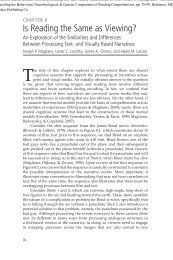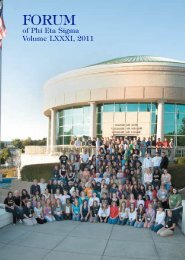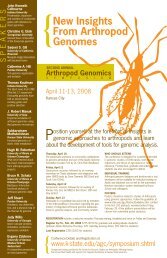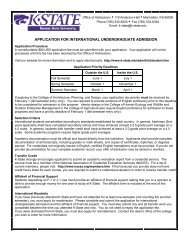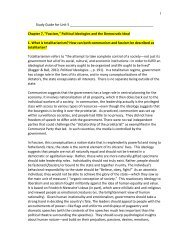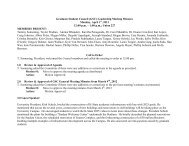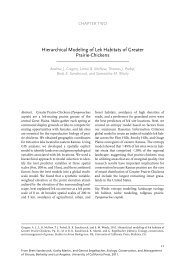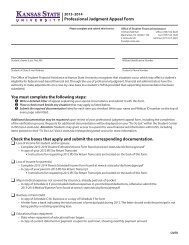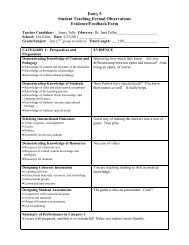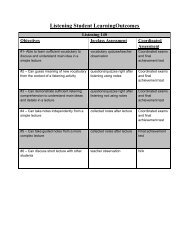Estimation of Demographic Parameters from Live ... - BioOne
Estimation of Demographic Parameters from Live ... - BioOne
Estimation of Demographic Parameters from Live ... - BioOne
Create successful ePaper yourself
Turn your PDF publications into a flip-book with our unique Google optimized e-Paper software.
distributions may be the only option under certain<br />
conditions, such as analysis <strong>of</strong> specimens in natural history<br />
collections (Ricklefs 1997, Rohwer 2004). However, age<br />
distributions have less value for field studies <strong>of</strong> wildlife<br />
populations because violations <strong>of</strong> the underlying assumptions<br />
are likely to lead to biased estimates <strong>of</strong> survival (Kelly<br />
and Finch 2000, Conn et al. 2005, but see Ricklefs and<br />
Rohwer 2005).<br />
Radiotelemetry is a key tool for monitoring wildlife<br />
species, and investigators can conduct survival analyses based<br />
on telemetry data with a range <strong>of</strong> different statistical<br />
procedures (Williams et al. 2002). The drawbacks to<br />
telemetry for estimation <strong>of</strong> annual survival rates for wildlife<br />
populations are mainly practical considerations. The current<br />
battery life, size, and range <strong>of</strong> conventional and satellite<br />
transmitters prohibit monitoring <strong>of</strong> small-bodied species <strong>of</strong><br />
migratory animals throughout their annual cycle. Transmitters<br />
are more intrusive than individual tags, and attachment<br />
techniques should not affect demographic rates<br />
(Hagen et al. 2006, Mong and Sandercock 2007). Radiotelemetry<br />
is an expensive technology and the financial costs<br />
<strong>of</strong> transmitters and tracking effort restrict the number <strong>of</strong><br />
individuals that investigators can monitor in a population<br />
study.<br />
Dead recoveries and live encounters <strong>of</strong> individually marked<br />
animals have been widely used to estimate survival rates for<br />
wildlife species. Dead-recovery data require that observers<br />
locate and report individually marked animals after harvest<br />
or natural death. Among North American birds, the<br />
proportion <strong>of</strong> bands recovered ( ^f ) is adequate for hunted<br />
species <strong>of</strong> waterfowl (median ^f ¼ 0.135, n ¼ 35 spp.; Franklin<br />
et al. 2002) but dismal for nongame species <strong>of</strong> shorebirds<br />
(0.014, n ¼ 28; Wilcox 1959) and songbirds (0.004, n ¼ 225;<br />
Francis 1995). Recovery models may have greater utility for<br />
European birds because established ringing programs have<br />
marked larger samples <strong>of</strong> birds over longer periods <strong>of</strong> time<br />
and reporting rates seem to be higher (Paradis et al. 1998,<br />
Piersma et al. 2005).<br />
While alternative sources <strong>of</strong> information have their merits,<br />
live-encounter data <strong>of</strong>ten remain the only feasible method<br />
for estimating annual survival rates for nongame species <strong>of</strong><br />
wildlife. Statistical methods for analysis <strong>of</strong> live-encounter<br />
data have advanced greatly in recent years, with development<br />
<strong>of</strong> new mark–recapture models (Williams et al. 2002),<br />
new model-selection procedures based on information<br />
theory (Burnham and Anderson 1998, Johnson and Omland<br />
2004, Stephens et al. 2005), and new s<strong>of</strong>tware tools (White<br />
and Burnham 1999). The goals <strong>of</strong> this article are: 1) to<br />
present a summary review <strong>of</strong> the 7 major classes <strong>of</strong> openpopulation<br />
mark–recapture models that investigators can use<br />
to estimate demographic parameters <strong>from</strong> live-encounter<br />
data, 2) to discuss potential advantages and drawbacks <strong>of</strong><br />
these 7 models, and 3) to highlight empirical applications<br />
where these models have been applied to wildlife populations<br />
under field conditions.<br />
I defined the scope <strong>of</strong> this article in 4 ways. First, mark–<br />
recapture models for live-encounter data are primarily used<br />
to estimate survival and abundance (Caswell and Fujiwara<br />
2004), but I consider their utility for estimation <strong>of</strong> other<br />
demographic parameters as well. Second, I focus on open<br />
population models for estimation <strong>of</strong> transition probabilities,<br />
but note that closed population models have other<br />
advantages for analyses <strong>of</strong> live-encounter data. Third, I<br />
emphasize estimation <strong>of</strong> annual rates, but investigators can<br />
use mark–recapture models to estimate parameters for a<br />
variety <strong>of</strong> time intervals. Fourth, I discuss applications to<br />
wildlife populations, but investigators can also apply mark–<br />
recapture models for live-encounter data to plants (Shefferson<br />
et al. 2003, Kéry and Gregg 2004), insects (Auckland et<br />
al. 2004), fish (Labonne and Gaudin 2005), and other<br />
organisms. A final caution is that the notation for<br />
demographic parameters in mark–recapture models has<br />
not been standardized. Investigators have used alternative<br />
symbols to denote the same parameter (e.g., site fidelity: F<br />
or g; seniority: f or c) and the same symbol to denote<br />
separate parameters in different mark–recapture models<br />
(e.g., s: site propensity or transience; c: temporary<br />
emigration or seniority). In my notation, I followed<br />
conventions <strong>of</strong> the published literature but avoided use <strong>of</strong><br />
identical symbols for parameters <strong>from</strong> different models.<br />
Return Rates<br />
One metric that commonly is used as an index <strong>of</strong> annual<br />
survival for wildlife populations is the return rate, the<br />
proportion <strong>of</strong> marked individuals marked in a year <strong>of</strong><br />
sampling that are recaptured the following year or in some<br />
block <strong>of</strong> future years. The probability <strong>of</strong> capturing an<br />
individual animal in 2 consecutive years at a single sampling<br />
site is the product <strong>of</strong> 4 separate probabilities:<br />
1) True survival (S): the probability that an individual<br />
survives between 2 sampling periods.<br />
2) Site fidelity (F): the probability that an individual returns<br />
to the same sampling area and does not permanently<br />
emigrate, if it is still alive (with probability S).<br />
3) Site propensity (d): the probability that an individual is<br />
available for encounter in the same sampling area the next<br />
year, if it is alive (with probability S) and in the sampling<br />
area (with probability F).<br />
4) True detection (p*): the probability that an observer<br />
detects the individual under field conditions, given that<br />
the individual is alive (with probability S), in the<br />
sampling area (with probability F), and available for<br />
encounter (with probability d).<br />
As the product <strong>of</strong> these 4 probabilities (rr ¼ S 3 F 3 d 3<br />
p*), return rates (rr) are a minimum estimate <strong>of</strong> true survival.<br />
If return rates are high (rr . 0.8), then true survival and<br />
each <strong>of</strong> the other 3 probabilities must be higher still.<br />
Difficulties arise in the interpretation <strong>of</strong> low or moderate<br />
return rates (rr , 0.6) and in comparisons <strong>of</strong> variation in<br />
return rates among different groups or years. A low return<br />
rate (rr ¼ 0.4) could be the result <strong>of</strong> poor survival (rr ¼ 0.55<br />
3 0.9 3 0.9 3 0.9 ¼ 0.4), weak site fidelity (rr ¼ 0.9 3 0.55 3<br />
0.9 3 0.9 ¼ 0.4), or any other possible combination <strong>of</strong> the 4<br />
Sandercock Mark–Recapture Analyses <strong>of</strong> <strong>Live</strong>-Encounter Data 1505



